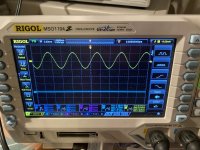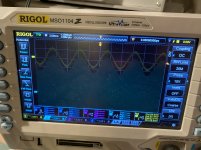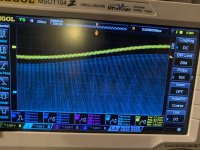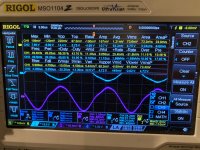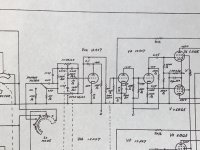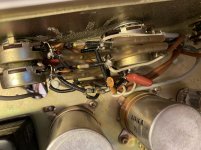@petertub Are you saying it's pointless to use a tube tester? I'm testing with 250V and 200V for anode and screen, and -1V for grid, as indicated in the manual.
Yes if you have an amp where the tube is placed. And for values of test it is the tube data sheet that should be used ( not the tube testers, they are limited in the actual testers abilities).@petertub Are you saying it's pointless to use a tube tester? I'm testing with 250V and 200V for anode and screen, and -1V for grid, as indicated in the manual.
My impression is that tube testers creates more problems then it serves.
Aside of shorts, are there any condition in which a tube could damage the equipment you put it in?
Allright, I guess this is evolving to something other than "do I have to replace caps".. but since there are knowledgeable people here, and others with the same amp as well, and I kind of feel like I know you a little bit.. here goes.
There is some kind of oscillation at 49.5Khz going on in the right channel. This makes it oscillate at full volume, and leaks over to the left channel, as you've seen in previous posts. Now, the signal is present at the grid of V3a, but removing V3 has no effect. Removing V4 is the only thing that works, Then, left channel behaves normally.
So the error seems to be in the equalizer circuit. There are some old ceramics there, I suspect some of them wasn't pleased with the shock they got when connecting cables.
They're not exactly easy to get to, though. And I'm no expert on this, but I wonder - are these class 2 ceramics? If I replace them with C0G, will I mess up? The reason I'm asking, is because this area is upside, where the tubes are - i.e. it's hot, and has a somewhat stable temperature. Could it be they chose the capacitance value based on the dielectric's performance in the temperature range these ceramics are situated? Or am I making this way more complex than it needs to be?
I have attached a few scope images, part of the schematic and a picture of the crampy areas where these are situated. I would very much like to know if you agree with my assessment or not - dismantling and getting to these caps is not something I look forward to..
There is some kind of oscillation at 49.5Khz going on in the right channel. This makes it oscillate at full volume, and leaks over to the left channel, as you've seen in previous posts. Now, the signal is present at the grid of V3a, but removing V3 has no effect. Removing V4 is the only thing that works, Then, left channel behaves normally.
So the error seems to be in the equalizer circuit. There are some old ceramics there, I suspect some of them wasn't pleased with the shock they got when connecting cables.
They're not exactly easy to get to, though. And I'm no expert on this, but I wonder - are these class 2 ceramics? If I replace them with C0G, will I mess up? The reason I'm asking, is because this area is upside, where the tubes are - i.e. it's hot, and has a somewhat stable temperature. Could it be they chose the capacitance value based on the dielectric's performance in the temperature range these ceramics are situated? Or am I making this way more complex than it needs to be?
I have attached a few scope images, part of the schematic and a picture of the crampy areas where these are situated. I would very much like to know if you agree with my assessment or not - dismantling and getting to these caps is not something I look forward to..
Attachments
So I started molesting the tone control, before realizing that this made no sense. A refreshed look at the schematic, plus some new measurements made that perfectly clear.
1) Oscillation stops if V4 is removed
2) Grid of V3a has the same oscillation, but..
2) ..oscillation can be found in the entire circuit.. even at both sides of the 0.02µF capacitor by the rumble filter (see partial schematic in previous post)
Thankfully, I only removed one resistor and one cap from each channel in the tone circuit (the 100pf and 100KOhm that can be seen next to the 0.02µF coupling cap after the rumble filter).
So I thought, ok, maybe there's something iffy going on at the cathode of V4. Not that I'm any expert at this, but when you hear a voice and feel smartness creep in, why not check it out.
I put a probe over the 47µF cathode cap of V4(a). But now, the signal was silent (some SMPS noise over the cathode cap, but that's it). Then, I removed the probe. And right channel went into full oscillation. I had no idea a pair of beaten EL84s could deliver 24.5W.
So here's where my skills start to fade. What could cause a 10M resistor (i.e. my scope probes) over the cathode cap to remove the oscillation? There's already a 1K cathode resistor in parallel with the capacitor.
My scope is grounded, but not connected to the isolation transformer (which the variac + amp is). It's late, and I'm just an amateur.
Any wisdom, input or otherwise is greatly appreciated!
1) Oscillation stops if V4 is removed
2) Grid of V3a has the same oscillation, but..
2) ..oscillation can be found in the entire circuit.. even at both sides of the 0.02µF capacitor by the rumble filter (see partial schematic in previous post)
Thankfully, I only removed one resistor and one cap from each channel in the tone circuit (the 100pf and 100KOhm that can be seen next to the 0.02µF coupling cap after the rumble filter).
So I thought, ok, maybe there's something iffy going on at the cathode of V4. Not that I'm any expert at this, but when you hear a voice and feel smartness creep in, why not check it out.
I put a probe over the 47µF cathode cap of V4(a). But now, the signal was silent (some SMPS noise over the cathode cap, but that's it). Then, I removed the probe. And right channel went into full oscillation. I had no idea a pair of beaten EL84s could deliver 24.5W.
So here's where my skills start to fade. What could cause a 10M resistor (i.e. my scope probes) over the cathode cap to remove the oscillation? There's already a 1K cathode resistor in parallel with the capacitor.
My scope is grounded, but not connected to the isolation transformer (which the variac + amp is). It's late, and I'm just an amateur.
Any wisdom, input or otherwise is greatly appreciated!
I recently inherited one of these, don't need it so have had a restore in the back of my mind before sale. Question is what do these puppies go for and will the cost of a full restore be realized in the final sale price or should I move as is. Last time I checked they were fetching relatively small money compared to more famous brands like LEAK.
Shoog
Shoog
Still puzzled by this. If I turn the volume up, the signal is attenuated somewhat, but not much. Whether V3 is in place or not doesn't make any difference.
When measuring on the input side of the volume pot, the "bias" of the input signal shifts up and down, then stabilizes.
Touching Probe ground clip to lower end of cathode cap/resistor stops the oscillation.
When measuring on the input side of the volume pot, the "bias" of the input signal shifts up and down, then stabilizes.
Touching Probe ground clip to lower end of cathode cap/resistor stops the oscillation.
- Home
- Amplifiers
- Tubes / Valves
- Old tube amp - do non-electrolytics need replacement?
